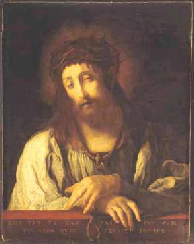Nicolaus Ludwig, Count von Zinzendorf, son of the Prime Minister of Saxony, was born in Dresden in 1700.
 On one occasion he visited the art gallery in Düsseldorf and saw the painting "Ecce Homo."
On one occasion he visited the art gallery in Düsseldorf and saw the painting "Ecce Homo."
This painting by Italian baroque painter Domenico Feti (1589-1624) represents the Saviour, flogged, worn out and crowned with thorns, as he was presented by Pilate to the waiting crowd - "Behold the Man!" ( Ecce Homo!)
The words in Latin across the bottom of the painting read, "All this have I done for you. What are you doing for me?"
This marked a major turning-point in his life and he became a key figure in a movement which came to be known as the Moravian Brethren. Zinzendorf stressed "heart religion" as well as Christian community, worldwide evangelism and ecumenical relationships.
John Wesley owed his conversion in 1738 largely to the Moravian Peter Böhler.
In January 1858, Frances Ridley Havergal was in Germany. She saw the same painting. The words so impressed her that she wrote her first hymn, which begins with the words,
Thy life was given for me,
thy blood , O Lord was shed,
that I might ransomed be,
and quickened from the dead:
thy life was given for me;
what have I given for thee?
thy blood , O Lord was shed,
that I might ransomed be,
and quickened from the dead:
thy life was given for me;
what have I given for thee?
We know her best for the hymn, "Take my life" (AHB 520) - and its climax,
Take my love: my Lord, I pour
at thy feet its treasure-store.
Take myself, and I will be
ever, only, all for thee.
at thy feet its treasure-
Take myself, and I will be
ever, only, all for thee.
Paul wrote, "You are not your own; you were bought with a price." What is the response of our life to the grace of God given at such cost for us?
© Peter J Blackburn 2002.
Scripture quotations from New International Version © International Bible Society, 1984
Scripture quotations from New International Version © International Bible Society, 1984
